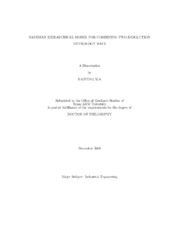| dc.contributor.advisor | Ding, Yu | |
| dc.creator | Xia, Haifeng | |
| dc.date.accessioned | 2010-01-14T23:54:36Z | |
| dc.date.accessioned | 2010-01-15T23:59:23Z | |
| dc.date.available | 2010-01-14T23:54:36Z | |
| dc.date.available | 2010-01-15T23:59:23Z | |
| dc.date.created | 2008-12 | |
| dc.date.issued | 2010-01-14 | |
| dc.identifier.uri | https://hdl.handle.net/1969.1/ETD-TAMU-2008-12-164 | |
| dc.description.abstract | This dissertation presents a Bayesian hierarchical model to combine two-resolution
metrology data for inspecting the geometric quality of manufactured parts. The high-
resolution data points are scarce, and thus scatter over the surface being measured,
while the low-resolution data are pervasive, but less accurate or less precise. Combining the two datasets could supposedly make a better prediction of the geometric
surface of a manufactured part than using a single dataset. One challenge in combining the metrology datasets is the misalignment which exists between the low- and
high-resolution data points.
This dissertation attempts to provide a Bayesian hierarchical model that can
handle such misaligned datasets, and includes the following components: (a) a Gaussian process for modeling metrology data at the low-resolution level; (b) a heuristic
matching and alignment method that produces a pool of candidate matches and
transformations between the two datasets; (c) a linkage model, conditioned on a
given match and its associated transformation, that connects a high-resolution data
point to a set of low-resolution data points in its neighborhood and makes a combined
prediction; and finally (d) Bayesian model averaging of the predictive models in (c)
over the pool of candidate matches found in (b). This Bayesian model averaging
procedure assigns weights to different matches according to how much they support
the observed data, and then produces the final combined prediction of the surface based on the data of both resolutions.
The proposed method improves upon the methods of using a single dataset as
well as a combined prediction without addressing the misalignment problem. This
dissertation demonstrates the improvements over alternative methods using both simulated data and the datasets from a milled sine-wave part, measured by two coordinate
measuring machines of different resolutions, respectively. | en |
| dc.format.mimetype | application/pdf | |
| dc.language.iso | en_US | |
| dc.subject | Bayesian hierarchical model | en |
| dc.subject | Bayesian model averaging | en |
| dc.subject | Data combining | en |
| dc.subject | Gaussian process | en |
| dc.subject | Misalignment | en |
| dc.subject | Two-resolution data | en |
| dc.title | Bayesian Hierarchical Model for Combining Two-resolution Metrology Data | en |
| dc.type | Book | en |
| dc.type | Thesis | en |
| thesis.degree.department | Industrial and Systems Engineering | en |
| thesis.degree.discipline | Industrial Engineering | en |
| thesis.degree.grantor | Texas A&M University | en |
| thesis.degree.name | Doctor of Philosophy | en |
| thesis.degree.level | Doctoral | en |
| dc.contributor.committeeMember | Mallick, Bani K. | |
| dc.contributor.committeeMember | Peters, Brett A. | |
| dc.contributor.committeeMember | Wang, Jyhwen | |
| dc.type.genre | Electronic Dissertation | en |


